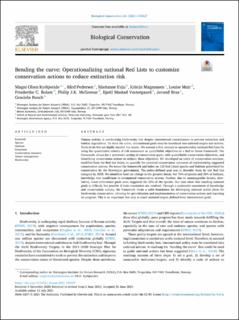| dc.contributor.author | Kyrkjeeide, Magni Olsen | |
| dc.contributor.author | Pedersen, Bård | |
| dc.contributor.author | Evju, Marianne | |
| dc.contributor.author | Magnussen, Kristin | |
| dc.contributor.author | Mair, Louise | |
| dc.contributor.author | Bolam, Friederike C. | |
| dc.contributor.author | McGowan, Philip J.K. | |
| dc.contributor.author | Vestergaard, Kjetil Mastad | |
| dc.contributor.author | Braa, Jørund | |
| dc.contributor.author | Rusch, Graciela | |
| dc.date.accessioned | 2023-01-05T13:51:22Z | |
| dc.date.available | 2023-01-05T13:51:22Z | |
| dc.date.created | 2021-08-02T11:59:40Z | |
| dc.date.issued | 2021 | |
| dc.identifier.citation | Biological Conservation. 2021, 261 . | en_US |
| dc.identifier.issn | 0006-3207 | |
| dc.identifier.uri | https://hdl.handle.net/11250/3041304 | |
| dc.description.abstract | Human activity is accelerating biodiversity loss despite international commitments to prevent extinction and habitat degradation. To bend the curve, international goals must be translated into national targets and actions. Tools to do this are highly needed, but scarce. We present a first attempt to operationalize national Red Lists by using the quantitative criteria of risk assessment as quantifiable objectives in a Red to Green framework. The framework allows for a systematic setting of conservation goals, with quantifiable conservation objectives, and identifying conservation actions to achieve these objectives. We developed an index of conservation outcome, modified from the Red List Index, to quantify the potential conservation outcomes of implementing suggested conservation actions. We tested the framework and index on 123 Red Listed species and habitats prioritized for conservation by the Norwegian government. The policy-defined goal was to downlist them by one Red List category by 2035. We identified land use change as the greatest threat. For 70% of species and 20% of habitats, knowledge was insufficient to recommend conservation actions. Further, due to unmanageable threats, alter-native, lower-ambitioned goals were suggested for 30% of the species. Our case show that reaching national goals is difficult, but possible if main constraints are resolved. Through a systematic assessment of knowledge and conservation actions, the framework forms a solid foundation for developing national action plans for biodiversity conservation, allowing for prioritization and implementation of conservation actions and reporting on progress. This is an important first step to reach national targets defined from international goals. Species Habitats Ecosystem Conservation measures Nature management Biodiversity | en_US |
| dc.language.iso | eng | en_US |
| dc.rights | Navngivelse 4.0 Internasjonal | * |
| dc.rights.uri | http://creativecommons.org/licenses/by/4.0/deed.no | * |
| dc.subject | Species | en_US |
| dc.subject | Habitats | en_US |
| dc.subject | Ecosystem | en_US |
| dc.subject | Conservation measures | en_US |
| dc.subject | Nature management | en_US |
| dc.subject | Biodiversity | en_US |
| dc.title | Bending the curve: Operationalizing national Red Lists to customize conservation actions to reduce extinction risk | en_US |
| dc.type | Peer reviewed | en_US |
| dc.type | Journal article | en_US |
| dc.description.version | publishedVersion | en_US |
| dc.rights.holder | © 2021 The Authors | en_US |
| dc.subject.nsi | VDP::Zoologiske og botaniske fag: 480 | en_US |
| dc.subject.nsi | VDP::Zoology and botany: 480 | en_US |
| dc.source.volume | 261 | en_US |
| dc.source.journal | Biological Conservation | en_US |
| dc.identifier.doi | 10.1016/j.biocon.2021.109227 | |
| dc.identifier.cristin | 1923395 | |
| dc.relation.project | Andre: Norwegian Environmental Agency | en_US |
| dc.source.articlenumber | 109227 | en_US |
| cristin.ispublished | true | |
| cristin.fulltext | original | |
| cristin.qualitycode | 2 | |

